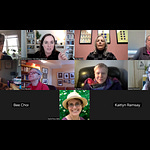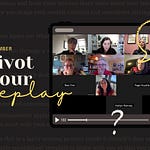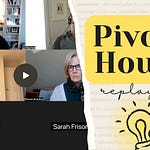Thank you
, , , and many others for tuning into my live video! Join me for my next live video in the app.This month in The Editing Spectrum, we are focusing on publishing principles — what it means to move from blogger to publisher and how to build a supportive publishing system around your newsletter. Today’s live stream was an open Q&A on the hardest parts of publishing a newsletter, and we covered everything from writing shorter posts to crafting better calls to action.
Here are some of the key questions that came up.
1. “How can I learn to write shorter posts?”
Takeaway: Why do you think they need to be shorter? Sometimes we assume shorter is better, but sometimes your readers long for longer.
If you feel like you're meandering, it helps to remember that the best essays communicate one really clear thought.
If you try to give readers 10 things to take away, they will take none of those things away.
Let your draft process be nourishing, then go back and ask: What’s the one gift I want to give my reader?
If your first draft has 10 gifts, then congratulations—you actually have 10 essays!
2. “What makes a call to action (CTA) work?”
Takeaway: A great CTA echoes your reader’s why—this is something we’re focusing on in The Editing Spectrum this month.
If you don’t know why your reader should want to read your newsletter, then your about page, welcome email, and CTAs will all feel unclear.
The best CTAs step inside your reader’s lived experience and connect to the theme of the essay.
Generic doesn’t work—"Buy now, subscribe now" is old-school. Readers need context and a reason to take action.
Calls to action should be visually and textually distinct each time. If your CTA always looks the same, readers will start to gloss over it.
Play with different formats—"What if balsamic vinegar wrote my CTA?"—to make them feel fresh and engaging.
3. “Should I turn on paid subscriptions if my goal is a bigger list?”
Takeaway: Turning on paid doesn’t help grow your list. Running a f*cking good newsletter does.
If your goal is list growth, your focus should be on creating an incredible free experience first.
A price tag doesn’t change the value of a product—the value has to be there first.
Right now, your best bet is to give yourself creative space to grow something great and to network with other like-minded creatives.
The best mindset is: "The more, the merrier."
4. “I’m writing memoir-style stories, but I’m not selling anything yet. What should my call to action be?”
Takeaway: The call to action is: Come hang out with me, I’m super cool.
Your newsletter is about inviting people into your world. Even if the long-term CTA is buy my book, the short-term CTA can be: “Let’s share our stories. Let’s have a conversation.”
The stuff of your life belongs inside your newsletter. Readers want to be in the garden of your writing.
If you’re wondering what to say, try this:
What if your vegetable garden wrote your CTA?
What would it sound like if balsamic vinegar wrote all of your CTAs for the next month?
Have fun with it. Make it engaging. Make it YOU. (Because, conceivably, the essence of your memoir is what will draw them in when it comes time to decide to buy it.)
5. “How do I keep my readers engaged long-term?”
Takeaway: Readers need to know where you’re going next.
A little bit of shape gives you room to be creative while helping readers feel anchored.
The whole point of structure is to let you get really messy inside it.
We often underestimate how much beauty we already have in our lives, and that beauty belongs inside our newsletters.
This month, we’re focusing on publishing principles — how to build shape around your newsletter so that readers know what to expect while still being surprised. The key is knowing your Reader’s Why — if you don’t know that, nothing else (CTAs, about pages, paid offerings) will land the way you want it to.
If you have more questions, drop them in the comments! And if someone actually writes a CTA from the perspective of balsamic vinegar, I need to see it. 😊














Share this post